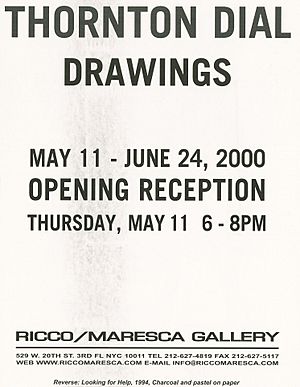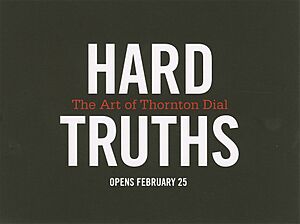Thornton Dial facts for kids
Quick facts for kids
Thornton DIAL
|
|
|---|---|
 |
|
| Born | September 28, 1928 |
| Died | January 25, 2016 (aged 87) |
| Nationality | American |
| Known for | assemblage paintings, sculpture |
| Spouse(s) | Clara Mae Murrow |
Thornton Dial (10 September 1928 – 25 January 2016) was an important American artist. He became well-known in the late 1980s. Dial created unique artworks called assemblages. These are sculptures or paintings made from everyday objects he found.
His art often explored big topics like human rights, natural disasters, and current events. Many of Dial's works are now in famous American museums. For example, the Metropolitan Museum of Art bought ten of his pieces in 2014.
Contents
Early Life and Artistic Beginnings
Thornton Dial was born in 1928 in Emelle, Alabama. He grew up on a former cotton plantation. His family members worked as sharecroppers, meaning they farmed land owned by others.
When he was about three, Thornton and his half-brother Arthur moved in with their cousin, Buddy Jake Dial. Buddy Jake was a farmer who also made sculptures from things he found. This experience greatly influenced young Thornton. He grew up in poverty and without his father.
In 1940, at age twelve, Dial moved to Bessemer, Alabama. He was amazed by the art he saw in people's yards there. He married Clara Mae Murrow in 1951. They had five children together.
His main job was working with metal at the Pullman Standard Plant in Bessemer, Alabama. This factory made railroad cars. The plant closed in 1981. After it closed, Dial began to focus on making art for his own enjoyment.
Becoming a Recognized Artist
In 1987, Thornton Dial met Lonnie Holley, another artist. Holley introduced Dial to William Arnett, an art collector and historian from Atlanta. Arnett was very interested in art by African-American artists. He helped bring Dial's work to national attention.
Arnett also helped other artists, like the Gee's Bend Quilters, become famous. In 1996, Arnett and Jane Fonda started a publishing company. He also founded the Souls Grown Deep Foundation. This group works to save and document African American art.
Dial's art has been shown in major exhibitions around the world. One important show was the 2000 Whitney Biennial. Over time, people began to see his art as more than just beautiful. They saw how it talked about important social and political issues.
His art expressed "ideas about black history, slavery, racial discrimination, urban and rural poverty, industrial or environmental collapse, and spiritual salvation."
A big change happened in 2011. An art historian named Joanne Cubbs organized a traveling show of Dial's work called "Hard Truths: The Art of Thornton Dial." This exhibition helped people see Dial as a true contemporary artist.
Karen Wilkin from The Wall Street Journal called his work "first-rate, powerful Art—with a capital ‘A.’" The Journal even named his show one of the best museum shows of 2011. It was listed alongside famous artists like Degas and Picasso.
Richard Lacayo, an art critic for Time Magazine, wrote a four-page story about Dial. He argued that Dial's work should not be called "outsider art." Lacayo said Dial's art should simply be seen as "art, just art." He called it "some of the most assured, delightful and powerful art around."
Carol Kino from New York Times also praised Dial's work. She said its look and ideas were similar to many other modern and contemporary masters. These included artists like Jackson Pollock and Jean-Michel Basquiat.
More recently, Alex Greenberger of ARTnews said that labels like "outsider artist" or "folk artist" might be wrong for Dial. He noted that Dial's work has been moving into the mainstream art world.
Artistic Style and Themes
Thornton Dial's art often explores big American social and political issues. These include war, racism, bigotry, and homelessness. He uses everyday objects that people might ignore to talk about these topics.
He combines paint with found materials to create large assemblages. These objects can be anything from rope to bones to old buckets. For example, works like Black Walk use old corrugated tin and other worn-out metal pieces. Dial's art often reflects the history of the American rural South.
The symbol of the tiger is also very important in Dial's art. Artist and historian David C. Driskell explained that Dial used the tiger to represent survival. It also hinted at the struggle for civil rights in the United States.
Major Exhibitions and Collections
In 1993, Dial's work was featured in a large exhibition. It was shown at both the New Museum of Contemporary Art and the American Folk Art Museum in New York. His art was also part of the Whitney Biennial in 2000.
From 2005 to 2006, the Museum of Fine Arts, Houston held a big show called "Thornton Dial in the 21st Century." This was followed by the major traveling exhibition "Hard Truths: The Art of Thornton Dial" from 2011 to 2013.
Dial's artworks are in many important public and private collections. These include the High Museum of Art, the Museum of Fine Arts, Houston, and the American Folk Art Museum. Other museums holding his work are the Philadelphia Museum of Art and the Smithsonian American Art Museum.
On November 24, 2014, The Metropolitan Museum of Art received a huge gift. The Souls Grown Deep Foundation donated 57 works by contemporary African American artists from the Southern United States. This gift included 10 works by Thornton Dial. An exhibition of these works opened at the Metropolitan Museum in May 2018.
Sheena Wagstaff, a leader at the Metropolitan Museum, said the gift was amazing. She noted that Dial's "magisterial constructions" greatly added to the museum's collection of contemporary American art.
In March 2016, two of Dial's major works were given to the Virginia Museum of Fine Arts. These were "Old Uncle Buck (The Negro Got to Find Out What's Going On in the United States)" from 2002, and the large sculpture "Freedom Cloth" from 2005.
The High Museum of Art in Atlanta held a memorial exhibition for Dial from February to May 2016. It showed many of his colorful drawings and symbolic paintings. After his death, Marianne Boesky Gallery also presented a show dedicated to Dial called "We All Live Under the Same Old Flag."
In 2018, David Lewis Gallery presented "Mr. Dial's America." This show looked at Dial's work from 1989 to 2011. It included early self-portraits and paintings about the Jim Crow–era and the fight for civil rights. It also featured works about the O.J. Simpson trial and the World Trade Center after the 9/11 attacks.
Roberta Smith, writing for the New York Times, praised Dial's ability to turn any material into a painting. She called his works "fiercely formal," connecting them to famous artists like Jackson Pollock and Anselm Kiefer.
Personal Life
Thornton Dial married Clara Mae Murrow in 1951. She passed away in 2005. When he died, he was survived by three sons: Thornton Jr., Richard, and Dan. He also had a daughter, Matte Dial, and many grandchildren and great-grandchildren.
Exhibitions
Dial's art has been shown in many places across the United States since 1990. Here are some of his museum exhibitions:
- 2022: Called To Create: Black Artists of the American South, National Gallery of Art, Washington, DC
- 2019: Home is a Foreign Place: Recent Acquisitions in Context, The Metropolitan Museum of Art, New York, NY
- 2019: Epic Abstraction: Pollock to Herrera, The Metropolitan Museum of Art, New York, NY
- 2018: History Refused to Die: Highlights from the Souls Grown Deep Foundation Gift, The Metropolitan Museum of Art, New York, NY
- 2017: Revelations: Art From the African American South, De Young Museum, San Francisco, CA
- 2016: Green Pastures: In Memory of Thornton Dial Sr., High Museum of Art, Atlanta
- 2015: I See Myself in You: Selections from the Collection, Brooklyn Museum, Brooklyn, NY
- 2014: When the Stars Begin to Fall: Imagination and the American South, The Studio Museum in Harlem, New York, NY
- 2011-2013: Hard Truths: The Art of Thornton Dial, Indianapolis Museum of Art (organizing museum); also shown at New Orleans Museum of Art, The Mint Museum, and the High Museum of Art
- 2005: Thornton Dial in the 21st Century, Museum of Fine Arts, Houston
- 2000: Whitney Biennial, Whitney Museum of American Art, New York
- 1993: Thornton Dial: Image of the Tiger, New Museum of Contemporary Art, New York; American Folk Art Museum, New York
Public Collections
Thornton Dial's works are held in many public art collections, including:
- Ackland Art Museum, Chapel Hill, NC
- American Folk Art Museum, New York, NY
- Birmingham Museum of Art, Birmingham, AL
- Brooklyn Museum of Art, New York, NY
- High Museum of Art, Atlanta, GA
- Hirshhorn Museum and Sculpture Garden, Washington D.C.
- Indianapolis Museum of Art, Indianapolis, IN
- The Metropolitan Museum of Art, New York, NY
- Museum of Fine Arts, Houston, TX
- Museum of Modern Art (MoMA), New York, NY
- Philadelphia Museum of Art, Philadelphia, PA
- Smithsonian American Art Museum, Washington D.C.
- Virginia Museum of Fine Arts, Richmond, VA
- Whitney Museum of American Art, New York, NY
Public Artworks
- Road to the Mountaintop (sculpture) (2014), Nashville, TN
- The Bridge (sculpture) (1997), Atlanta, GA



